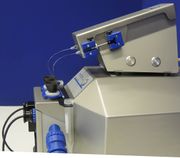Semantic search
From Bioblast
| Term | Abbreviation | Description |
|---|---|---|
| Spectrofluorometer | A spectrofluorometer makes use of a spectrometer to measure and analyse the fluorescent emission spectra from a fluorophore. It will typically differ from an absorbance spectrophotometer in that it will have a larger slit width (to increase sensitivity) and use a longer integration time. The configuration of the illuminating and receiving optics also differ from spectrophotometry in that the excitation source is directed perpendicularly to the position of the emission detector so that the intensity of the excitation signal reaching the detector is minimised. | |
| Spectroscopy | Spectroscopy is a broader term than spectrophotometry in that it is concerned with the investigation and measurement of spectra produced when matter interacts with or emits any form electromagnetic radiation. | |
| Spline | Some spectrofluorometer or spectrophotometer software offers the possibility of spline interpolation of the spectral data points. This makes use of a polynomial (the number of spline points is entered by the user) to interpolate the curve between the data points. | |
| Stability | Stability determines the accuracy of intensity and absorbance measurements as a function of time. Instability (see drift introduces systematic errors in the accuracy of fluorescence and absorbance measurements. | |
| Steady state | A system is in a steady state if the state variables of a dynamic system do not change over time due to exchange processes with the environment, which compensate for internal dissipative transformations — such as chemical reactions or diffusion — and thus prevent any changes of the system and externalize dissipative changes to the environment. The dynamic nature of the steady state differentiates it from the thermodynamic equilibrium state. {Quote} Steady states can be obtained only in open systems, in which changes by internal transformations, e.g., O2 consumption, are instantaneously compensated for by external fluxes across the system boundary, e.g., O2 supply, thus preventing a change of O2 concentration in the system (Gnaiger 1993). Mitochondrial respiratory states monitored in closed systems satisfy the criteria of pseudo-steady states for limited periods of time, when changes in the system (concentrations of O2, fuel substrates, ADP, Pi, H+) do not exert significant effects on metabolic fluxes (respiration, phosphorylation). Such pseudo-steady states require respiratory media with sufficient buffering capacity and substrates maintained at kinetically-saturating concentrations, and thus depend on the kinetics of the processes under investigation. {end of Quote: BEC 2020.1}. Whereas fluxes may change at a steady state over time, concentrations are maintained constant. The 'respiratory steady state' (Chance and Williams 1955) is characterized by constant fluxes (O2 flux, H2O2 flux) and measured variables of state (cytochrome redox states, Q redox state, NADH redox state, mitochondrial membrane potential). High-resolution respirometry allows for the measurement of several parameters (e.g. O2 flux, H2O2 flux, mitochondrial membrane potential) at pseudo-steady states, when changes of concentrations in the closed system do not exert any control on fluxes. Combination with the Titration-Injection microPump (TIP2k) allows operation with programmable titration regimes at steady-state ADP concentration (Gnaiger 2001), oxygen concentration (oxystat mode; Gnaiger et al 2000, Harrison et al 2015) or steady-state pH (pH-stat more), yielding an expanded flexibility in experimental design by combining the technical advantages of closed and open systems approaches. | |
| Stray light | Stray light is defined as the detected light of any wavelength that lies outside the bandwidth of the selected wavelength. In the presence of stray light of intensity Is, the equation for transmittance (T) becomes T = (I + Is)/(I0 + Is) where I0 is the incident light intensity and I is the transmitted light intensity. Clearly, the lower the value of I, the more dominant becomes the stray light term and so can cause errors in the quantification of low fluorescence signals or at high levels of absorbance. | |
| TIP2k-Module | TIP2k-Module - Titration-Injection microPump (TIP2k) for two-channel operation with the O2k-FluoRespirometer with automatic control by DatLab of programmable titration regimes and feedback control (oxystat, pH-stat). | |
| TMRM | TMRM | TMRM (tetramethylrhodamine methyl ester) is an extrinsic fluorophore used as a probe to determine changes in mitochondrial membrane potential. TMRM is a lipophilic cation that is accumulated in the mitochondrial matrix in proportion to Δψmt. Upon accumulation of the dye it exhibits a red shift in its absorption and fluorescence emission spectrum. The fluorescence intensity is quenched when the dye is accumulated in the mitochondrial matrix. |
| Taurine | Taurine, or 2-Aminoethan sulfonic acid, is one of the most abundant low-molecular-weight organic constituents in animals and humans. It has a multitude of functions in different types of tissue, one of which is the stabilization of membranes. Because of this and its antioxidative effect, taurine is a component of the respiration media MiR05 and MiR06 to preserve mitochondrial function. | |
| Wavelength averaging | Wavelength averaging is the averaging of several adjacent data points across the recorded spectrum (spectral smoothing), to improve the signal-to-noise ratio. For example, if the instrument recorded 5 data points per nm, the average of the 5 points can be taken for each successive nm across the range of the spectrum to give a 5-point smoothing. This method clearly reduces the wavelength resolution. |
